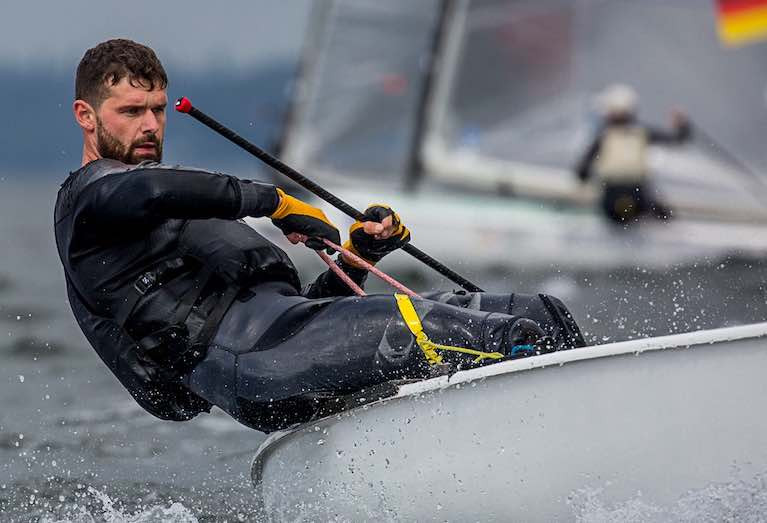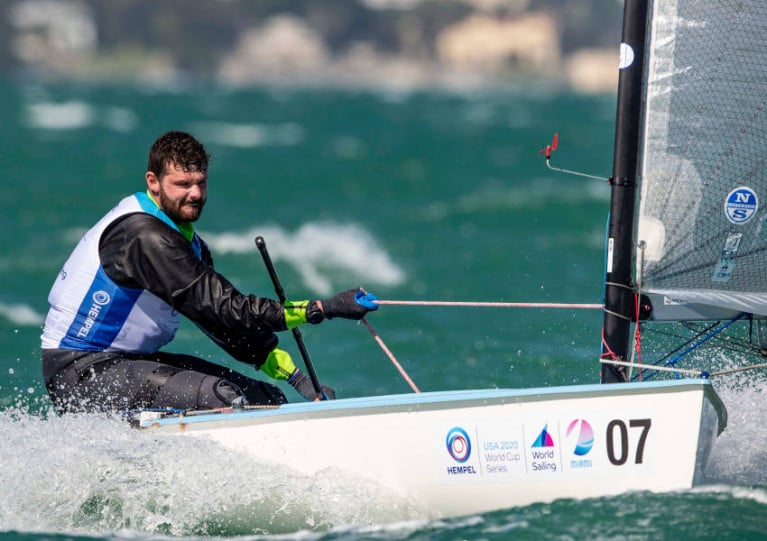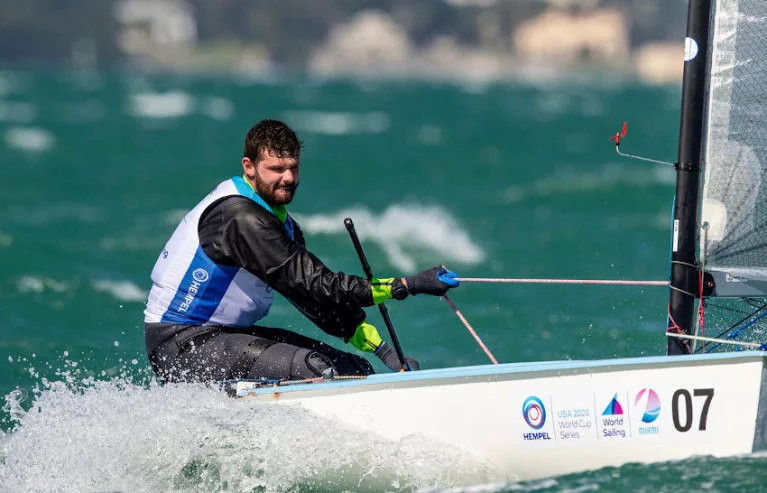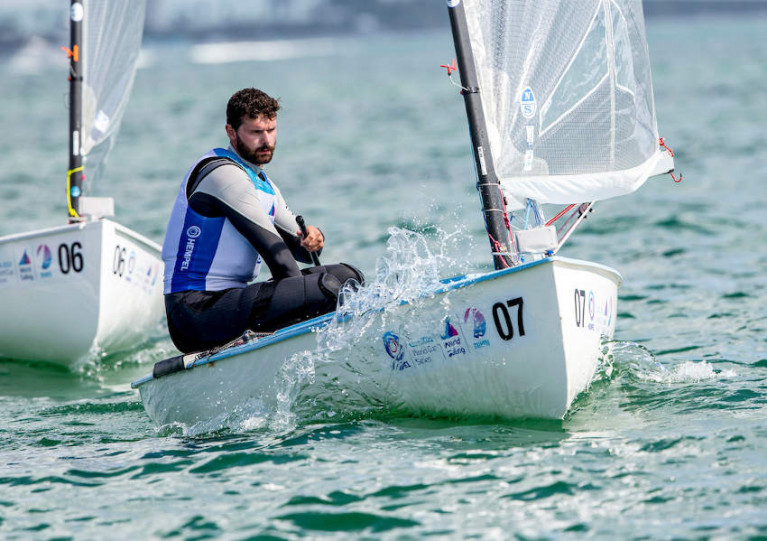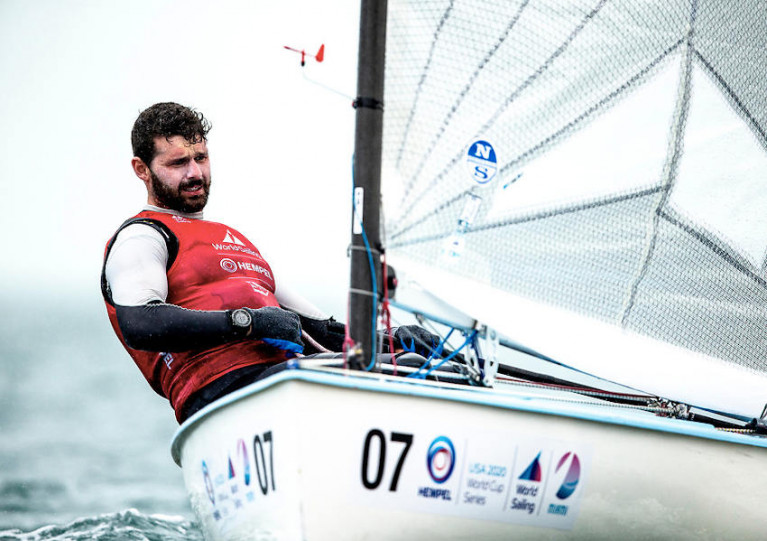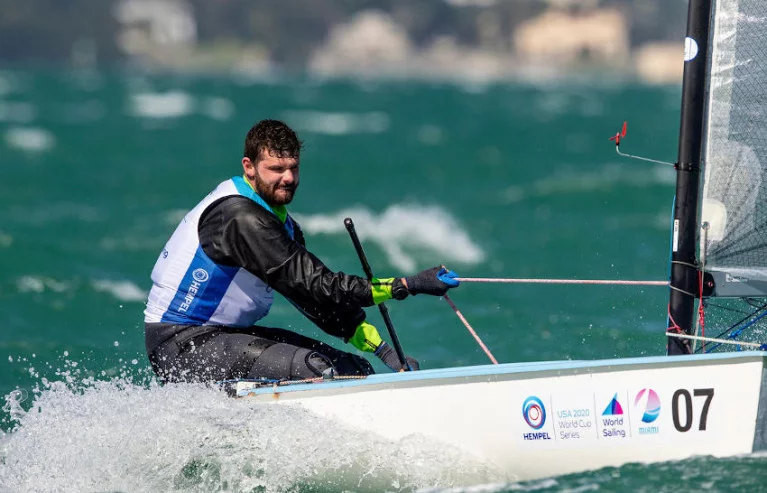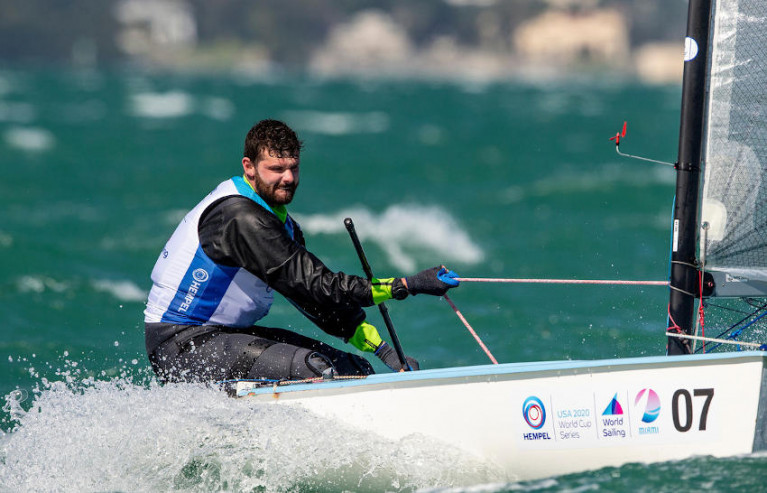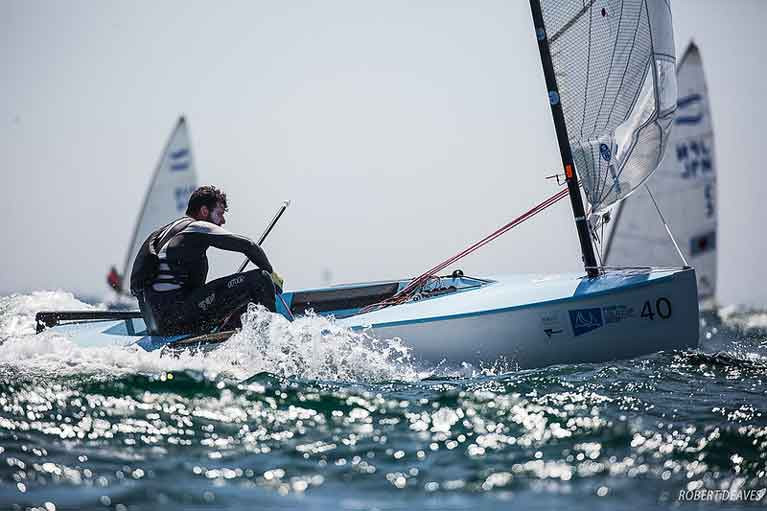Displaying items by tag: Oisin McClelland
Tokyo Olympic solo sailor campaigner Oisin McClelland of Donaghadee in Northern Ireland is among the entries for the 2021 Open and U23 Finn European Championship that gets underway in Vilamoura, Portugal, this morning with around 49 sailors from 29 nations competing.
Over the coming week, 10 races are scheduled up to Friday 16 April.
It's the penultimate regatta in McClelland's long road to qualifying Ireland in the Finn, a heavy weight men's class that McClelland has been campaigning since 2015.
McClelland of Donaghadee has secured several results with the top 32 Worlds, 23 in the 2020 Europeans and a credible 8th in Kieler Week.
Portugal will host the Finn Gold Cup early this May and McClelland, which will be a big event for McClelland. It will not only determine the 2021 Finn world champion but also the final two places at the Tokyo Olympic Games.
There are two places left to decide, one European place and one African place to complete the fleet taking part in the Games.
This week though, it's all about preparation for that do or die May event with sailors from around the globe now rigged up and ready to race in Portugal.
The furthest travelled for this event and taking part in his first major Finn event since 2019, is Jake Lilley, from Australia.
“It’s really nice to re-connect after an extended period away. It was great action when we were all together for the Gold Cup in Melbourne, so I’m really looking forward to more racing at the Euros and Gold Cup in Portugal this year.”
While he has not been racing in world quality fleets as usual, he has been able to train in large fleets in Australia
“Training in Australia has always presented its blessing in the Finn. We have beautiful conditions year round and the fleet is really thriving Down Under. My home club (RQYS) has 40 boats alone. It was amazing to be racing weekends with 30+ guys when the rest of the world was in lockdown. So it’s a bit of a disconnected feeling to what everyone else has had to go through.”
“I’m also super lucky with coach Rafa [Trujillo] and Finn legend, Anthony Nossiter, throwing their righting moment around for the long upwind slogs in domestic training. I think having the old school smarts and the help from two heroes is a beautiful thing and puts us in really good stead with speed and preparation. So it’s just up to me to put it all together on the racetrack now.”
Two of the British sailors have come almost direct from the America’s Cup in New Zealand. While Giles Scott, is preparing to defend his Olympic title in Tokyo in August, INEOS Team UK grinder, Ben Cornish, is also back in a Finn for a while, though he says it’s not a comeback.
“Giles asked if I could come and do some training with him, in his compact build-up the Olympics this summer. Of course I couldn’t say no.”
“It’s certainly not a comeback for me, but it’s a rare opportunity to compete in the Finn for pure enjoyment. Having been on the grinding wheel with the America’s Cup at INEOS Team UK for the past three years it’s refreshing to be thinking about ‘conventional’ racing and decision making, and of course with so many people I enjoyed racing over the past years.”
Cornish, who dropped out of his Olympic campaign and joined INEOS Team UK after the decision to drop the Finn from 2024 is expecting a very high standard of competition. “It’s clear to see that people have spent a lot of time training this winter and beyond through lockdowns. As we know people are looking to find form in Olympic year so I expect to see some strong results within the fleet.”
“I hope the venue delivers some good racing conditions and everyone can have an enjoyable week out on the race course.”
Three Northern Ireland sailors are all battling for a place at the Tokyo Olympic Regatta with qualification events taking place this week and in the next few weeks.
Ryan Seaton, Oisin McClelland and Liam Glynn have been training for over four years and are taking to the water in a bid to qualify the nation and secure their place at the Olympic Games in Tokyo.
In sailing, nations can qualify over ten Olympic disciplines but just one boat is eventually selected to represent each nation in each discipline.
The Northern Ireland athletes represent three different classes - the Finn, 49er and ILCA (formerly known as the Laser).
Double Olympic veteran and World Cup silver medallist, Ryan Seaton, from Carrickfergus, is paired with crew Seafra Guilfoyle from Cork, following his 10th place finish with Matt McGovern at Rio in 2016.
The pair had a solid start to this week's Regatta, which forms the final qualification event for the class. They had an 11-8-8 for the day in a 21 boat flight. Three days of qualification races will decide the split for Gold and Silver fleets on Wednesday that will go on to decide the medal race final on Friday (26 March) but currently, trail Dublin duo Robert Dickson and Sean Waddilove as Afloat reports here.
Ryan and Seafra finished 10th at the Olympic Test event in Enoshima and 30th at the 2020 World Championships.
Ahead of the race, Seaton commented: "It's all in, to qualify the nation. If we qualify, we will go to the Olympics. Seafra and I have been doing a serious amount of work over the past year, we are motivated and ready to put down a good performance.
"The outcome goal is to qualify for Tokyo 2021 and our process goals are to keep focused on our individual roles, to enjoy the racing and to believe in our ability as a team to perform.
"All the work is done now, and we are ready to enjoy the challenge. This is what it's all about, the big events, and performing at these events when it really counts".
Oisin McClelland of Donaghadee
Campaigning in the men's heavyweight Finn class since 2015, Oisin McClelland of Donaghadee has secured several results with the top 32 Worlds, 23 in the 2020 Europeans and a credible 8th in Kieler Week.
Portugal will host the Finn Gold Cup early this May and McClelland, which will be a big event for McClelland. It will not only determine the 2021 Finn world champion but also the final two places at the Tokyo Olympic Games.
There are two places left to decide, one European place and one African place to complete the fleet taking part in the Games.
 Oisin McClelland of Donaghadee Photo: Robert Deaves
Oisin McClelland of Donaghadee Photo: Robert Deaves
It is also the final World Championship for the class as an Olympic boat after the Finn was removed from the games for Paris 2024 and the future. The 2021 Finn Gold Cup will be decided over a 10 race series after the class decided to drop the medal race last year.
McClelland comments: "My primary goal is to qualify for Tokyo, it's the goal I have built this campaign around and I set out to achieve in 2016. However, that aside, this may be the last Finn Gold Cup held as an Olympic class I would really like to achieve a great result overall. I've made good progress despite the tough year, systematically targeting weaknesses and building them into strengths. I look forward to testing this in May."
He adds: "Give me the right conditions I can achieve some top-level race results, my focus going into the regatta is to combine the progress in each area of my training from the past three years and achieve the best result I can."
Liam Glynn, ILCA
For Liam Glynn of Ballyholme Yacht Club, the Olympic Qualifying event for the Lasers has been confirmed as the 2021 ILCA Vilamoura International Championship, taking place from 17-24 April.
This is the last chance for Liam to qualify the nation with two places up for grabs against Italy, Spain, Belgium and the Netherlands. Liam will be one of three other sailors to represent Ireland with stablemates Finn Lynch and Ewan McMahon.
 Liam Glynn of Ballyholme Yacht Club Photo: Thom Touw
Liam Glynn of Ballyholme Yacht Club Photo: Thom Touw
Rising through the youth and u21 ranks, securing a World Junior title and u21 Bronze along the way. Liam has shown steady progression in what is arguably one of the harder Olympic Classes to break. Most recently a 43rd in last October's European Championship shows encouraging signs for the future.
He comments: "I am looking forward to racing at the final Olympics qualification regatta. With two European spots still available to the goal is simple, finish in the top two non-qualified nations. I am very grateful for the opportunity to race against the best in the world, especially amid a global pandemic.
"It has been a challenging winter of training but I am pleased with my form and mindset in these final months preparation. I will set my sights firmly on what is achievable, with the help of my amazing support team, each day from now until the end of the regatta and enjoy the experience along the way."
Glynn adds: "It is an exciting prospect to be competing for Olympic qualification and I would love to give all the followers at home something to cheer for this summer."
RYA Northern Ireland's Performance Manager, Andrew Baker, says it is an exciting few months ahead for the sailors and supporters.
He comments: "These three events will be a milestone in the RYA Northern Ireland Performance Programme. Not only do we have three athletes representing across three different classes but they also stand out as large international events which over the past year have been few and far between due to Covid."
He adds: "I am very happy that we are in the position to have three sailors vying for Olympic qualification. All the sailors have worked their way through our club racing scene and performance pathways. The hard work is done, it is now time to trust in their training, believe in their ability and get out there to do it.
Donaghadee Sailing Club's Oisin McClelland Secures Top 25 position at European Finn Championships
Irish Tokyo 2021 solo campaigner, 27-year-old Donaghadee Sailing Club member Oisin McClelland has clinched a personal best, claiming 23rd spot at the Finn European Championships at Gdynia in Poland. The event ran from 1st to 6th September and was the sailor's first official race since lockdown took hold.
Consistent scoring throughout secured a position in the top 30 of the 70-strong fleet before the final challenging day on the Saturday at which point he was lying in 26th place with one day left. During Sunday's final races Oisin posted his best performances to date with an 18th and 11th which allowed him to climb back up the leader board into a final rank of 23rd. The winner was Zsombor Berecz of Hungary.
Speaking about his success, Oisin commented: "It is great to be back out racing for the first time since January at the European Championships. I had put a lot of work into my downwind sailing during lockdown and this really paid off, it got me out of trouble in such a tricky venue. I was pleased to finish strong in the last two races after a tough race on the previous day."
RYA Northern Ireland's newly appointed High Performance Manager, Andrew Baker, said: "it is fantastic to see Oisin back on the water and utilising the skills he worked so hard on during lockdown. To secure a top 25 spot at the European Championships is no mean feat and he should be proud of such a solid performance."
Oisin is now back on the road and heading for Kiel Week Regatta which runs from 10 – 13 September.
The countdown is on for three Northern Ireland sailors campaigning for their place at the Tokyo 2020 Olympic Games in late July this year, writes Betty Armstrong.
The athletes, who have been training for over four years, as part of their Olympic campaigns, will take to the waters on 11 April to battle it out at the nine-day qualifying competition in Genoa.
In the running is two-time Olympian and World Cup silver medallist Ryan Seaton, from Carrickfergus. Seaton paired up with new crew Seafra Guilfoyle from Cork in the 49er class, following his 10th place finish with Matt McGovern at Rio in 2016.
McGovern is now coach to the Irish 49er teams, all vying for an Olympic place.
Ryan and Seafra finished 10th at the Olympic Test event in Enoshima and recently finished 30th at the 2020 World Championships. They are embarking on a critical training phase in the lead up to the Olympic qualifier and subsequent European Championships in May.
Seaton comments: “Seafra and I have been training well and putting critical elements of speed and boat handling together over this winter period. Our focus has been to get more race practice and working under pressure to refine our performances and add consistency to a regatta week.”
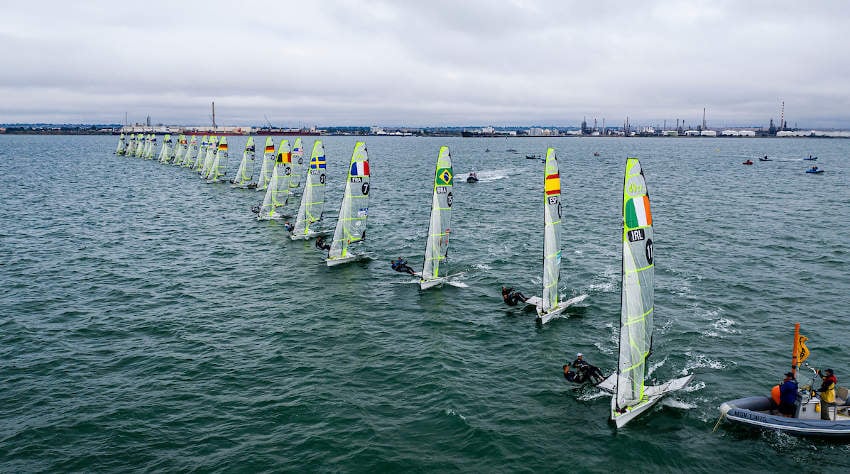 Ryan Seaton and Seafra Guilfoyle in action at the 49er Worlds in Australia last month | Photo: Jesus Renedo/Sailing Energy
Ryan Seaton and Seafra Guilfoyle in action at the 49er Worlds in Australia last month | Photo: Jesus Renedo/Sailing Energy
The Finn is a dinghy not normally associated with Donaghadee Sailing Club, but DSC member Oisin McClelland is another contender.
Campaigning in the men’s heavyweight Finn class since 2015, McClelland has secured several top 32 World and European finishes. In January he finished fourth in the Miami World Cup Series event, just narrowly missing out on a bronze medal.
He says: “Really nailing down all elements that make up a successful Olympic campaign was definitely difficult at the start but over time I have been able to get consistent and make big improvements.”
Ballyholme’s Liam Glynn is also gearing up for the challenge in Genoa. Rising through the youth and U21 ranks, he has secured a world junior title and U21 bronze along the way and recently achieved a personal best finish in the Laser at the recent World Championships in Australia.
As part of the Irish Performance Laser squad, the Bangor sailor has been training hard, with a typical day including up to six hours of training, looking at racing skills and focusing on nutrition and recovery.
Commenting on his Olympic campaign so far, Glynn says: “I am motivated by my love of the sport, the feeling when you are in the zone and perfecting your technique and strategy amongst the best sailors in the world.”
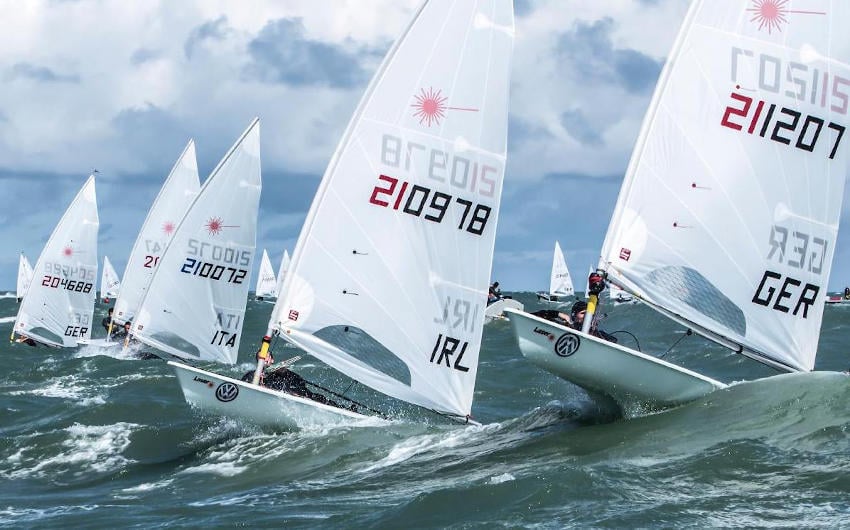 Liam Glynn recently scored a personal best result in the Laser
Liam Glynn recently scored a personal best result in the Laser
All three sailors graduated through the RYA Northern Ireland’s Performance Pathway and are funded through Sport Northern Ireland. Seaton and Glynn are members of the Irish Performance Team.
In sailing, nations can qualify in 10 Olympic disciplines but just one boat is eventually selected to represent each nation in each discipline.
For the NI athletes, their last chance for a European place in the Finn, Laser and 49er fleets is up for grabs at the Sailing World Cup next month.
RYA Northern Ireland’s chief operating officer Richard Honeyford, is looking forward to supporting the sailors as they make their final preparations.
“For all three boats the focus is now on one event in April and for the final chance to secure their place at Tokyo 2020,” he says. “All three have worked extremely hard during this Olympic cycle, with vast amounts of training, competing and travel to achieve their goal.
“At RYA Northern Ireland we are proud of how well they have applied themselves and their inspirational role as ambassadors for sailing in Northern Ireland.
“We look forward to the sailing community supporting them as they undertake this final challenge for Olympic qualification.”
RYANI Congratulates Oisin McClelland On Miami Finn Result
The RYANI has congratulated Donaghadee sailor Oisin McClelland on his strong showing at the Hempel World Cup Series in Miami last week.
As previously reported on Afloat.ie, the Finn sailor from Northern Ireland finished fourth, just shy of the podium, after Saturday’s (25 January) medal race on Biscayne Bay.
RYANI chief operating officer Richard Honeyford said: “Oisin sailed well throughout the week in Miami. He secured three top three finishes in the 10-race series and really showed his skill in the stronger breeze.
“While he narrowly missed out on the bronze and a podium place in the end, Oisin’s hard work and training throughout the year really paid off.
“He is a fantastic role model for our young sailors and at RYANI we look forward to supporting Oisin as he continues in his campaign for the Tokyo Olympics.”
McClelland will have one more last chance to claim a spot in this summer’s Tokyo Olympics at the final European qualifier, the Hempel World Cup series event in Genoa, Italy from 11 April.
Oisin McClelland Just Shy Of Bronze In Miami Finn Medal Race
Northern Ireland’s Oisin McClelland was resurgent on the waters of Biscayne Bay yesterday (Saturday 25 January) but finished just shy of the podium after the Finn medal race at the Hempel World Cup Series Miami.
The Donaghadee Sailing Club stalwart finished fifth in the final, ahead of Luke Muller of the USA whose points total over the week was enough to secure the bronze for himself.
As previously reported on Afloat.ie, American Caleb Paine had already won Finn gold ahead of the weekend with his unassailable lead over Canada’s Kyle Martin, who took the silver medal and finished second in yesterday’s race.
McClelland will have his last chance to claim a spot in this summer's Tokyo Olympics at the Hempel World Cup series event in Genoa, Italy from 11 April.
Yesterday's Finn medal race can be watched back in full below:
Oisin McClelland Stands Fourth Heading Into Finn Medal Race In Miami
Northern Ireland’s Oisin McClelland was off form on Friday (24 January) on Biscayne Bay as two seventh-place finishes saw him slip from the third place he’d held in recent days to fourth overall, heading into the Finn medal race at the Hempel World Cup Series event today (Saturday 25 January).
The fifth and final day of fleet racing wrapped up with the light breeze posing more challenges for the 182 sailors from 45 nations across the 470, RS:X, Laser, Laser Radial and Finn fleets — and testing the nerves of those with so much at stake.
Friday’s weather forecast was mostly sunny with temperatures in the mid-20s C. The breeze was on the low end throughout the day in the 5-6 knot range, and prompted a lengthy postponement in the afternoon, following which only the Finns were able to complete their racing schedule.
However, Caleb Paine of the United States has already won Finn gold ahead of the medal race as he has an unassailable lead over Canada’s Kyle Martin.
Across the 10-race series, Paine has taken five race wins and four seconds. An 11th in Race 9 yesterday was his worst score of the week. Martin of Canada won Race 10 and now stands in second place. while Luke Muller (USA), who is even on points with Martin, is in third.
McClelland of Donaghadee Sailing Club now stands in fourth, three points behind Muller in the overall Finn standings, following his worst performance of the week after Race 1, since which he’d consistently finished in the top five (excepting a discarded eighth in Race 8) and even scored a first place in Race 6.
But overall his week in south Florida is sure to boost his confidence going into the Genoa World Cup and the European continental spot for the Tokyo Olympics this summer.
“I’m 100% focused on that and this event is a good warm-up,” he said earlier this week.
Today’s medal races will be available to watch live on YouTube starting just after 9am in Miami (2pm in Ireland), with the Finns currently scheduled to start at 11.24am local time (4.24pm Irish time).
Oisin McClelland Holds Third In Finn Fleet As Light Wind Hampers Hempel World Cup Series In Miami
Northern Ireland’s Oisin McClelland maintains third place in the Finn class at the Hempel World Cup Series in Miami as cold temperatures, wind chill, rain, strong breeze, and more typical South Florida conditions challenged the 182 sailors from 45 nations yesterday (Thursday 23 January).
The challenge has been real on Biscayne Bay and this has created exciting racing and a level of unpredictability adding more intrigue to the annual Olympic class regatta.
Heading into Day 4’s racing yesterday, the Finn, Laser, Laser Radial and Men’s and Women’s 470 had completed six races, while the Men’s and Women’s RS:X finished nine.
However, the breeze failed to co-operate for most of Thursday, as rain showers sporadically dampened the sailing venue, and racing was limited after lengthy postponements.
American Caleb Paine won his fourth race of the regatta in Race 7 of the Finn class. He was third in Race 8 and leads by 17 points over Luke Muller (USA). Oisin McClelland of Donaghadee Sailing Club holds on to third, just two points behind Muller.
Meanwhile, the RS:X women and men managed just one race each, as did the Laser class. There was no racing in the Laser Radial or the 470 fleets.
Additional races are scheduled for the 470, Laser Radial and Laser today, Friday 24 January, with an earlier start time of 10.30am local (3.30pm Irish time).
Oisin McClelland Third In Finn Class Amid Unexpected Miami Conditions At Hempel World Cup Series
The 182 sailors embraced the challenge of the uncharacteristically cold and blustery conditions in Biscayne Bay on Day 3 of the 2020 Hempel World Cup Series Miami yesterday (Wednesday 22 January).
The athletes were faced with similar conditions on Tuesday, but Wednesday's overall shifty conditions and wind chill presented an even greater test of their physical and tactical skills.
Northern Ireland’s Oisin McClelland is in third place in the Finn class and trails American Luke Muller by three points. McClelland won Race 6 and placed fourth in Race 5.
“I managed to come out with a fourth and a first. A few people tipped it in, but I managed to stay upright and took the win,” said the Donaghadee Sailing Club stalwart.
Miami is the final opportunity for North Americans to qualify for Tokyo 2020, but the final stop of the 2020 Hempel World Cup Series in Genoa is the last shot for Europeans — McClelland included.
“The major goal for me is the Genoa World Cup and the European continental spot. The only one left for Europe. I’m 100% focused on that and this event is a good warm-up. There’s a couple of us here who are going for the spot — Ukraine and Russia. It’s a good early test to see how we’re going.
“We had some goals in mind for what I wanted to get out of this regatta — technique wise — but if the week goes well then I'd be really be pleased with a podium.”
Racing resumes at 11am EST (4pm Irish time) today, Thursday 23 January.
Northern Ireland Finn Sailor is 32 from 60 at Gold Cup in Australia
Josh Junior has become the first Kiwi to ever win the Finn Gold Cup after an epic medal race in Melbourne, Australia. Nick Heiner, from The Netherlands, took silver while 2018 world champion, Zsombor Berecz took bronze. Ireland was represented by Tokyo Olympic campaigner Oisin McClelland from Dongaghdee who has been seeking a Tokyo berth since 2016. He finished 32nd from 60 in Melbourne.
Earlier in the day, Ed Wright, from Britain, won the final race for the rest of the fleet, from Oskari Muhonen, from Finland and Jonathan Lobert, from France.
Even though he went into the medal race with a 16-point advantage over Heiner, Junior kept everyone guessing until the later stages of the race. He made hard work of the start, engaging with Heiner with a minute to go, but then allowing him to escape and control the start to lead up the first beat.
Starting in 20-22 knots, the wind gradually increased, as did the sea state, producing some epic racing conditions and supreme boat control. Heiner made the best of the first beat to round with a nice lead with Junior about sixth. Nothing much changed downwind, but a big shift to the left on the second upwind left Australia’s Jake Lilley in the lead followed by Berecz and Heiner. Junior was still back in seventh after losing out on the right.
While Lilley got away to win the race and move up to fifth overall, Berecz and Heiner battled downwind for silver and bronze. Berecz picked up a monster wave just short of the line and surged ahead, but Lilley was too far ahead to catch.
A mistake by Junior at this stage would have cost him the title, but he maintained control down on the final hairy downwind, to cross the line to whoops of joy. He had rewritten the history books, and despite a long line of celebrated Kiwi Finn sailors, he had become the first one ever to win the Finn Gold Cup.
Apart from Friday’s tricky races Junior was never out of the top five, leading from Day 2 all the way to the nail-biting finale. He entered the class in 2013 and has threatened brilliance ever since. But the years of hard work with Andy Maloney and coach Andrew Murdoch has finally paid off. It is an understatement to say he was pretty pleased with himself.
"I had a big lead but, to be fair, Heiner did a really good job at the start and on the first beat and he sort of got away on me. I was a bit worried I was in trouble of losing the whole regatta but I managed to hold it together and get the result I needed and I'm absolutely over the moon.”
"I have never won a world championships or even a medal so I'm stoked. There have been a lot of successful sailors in the Finn for New Zealand in the past and to be one of those is a great honour."
"It's been an outstanding week. I seem to have put pretty consistent results together and that's seen me near the front and took a bit of pressure off. But it's certainly a bit nerve racking. I have never been leading a world championship before, especially for so many days.”
His win makes the job of the Kiwi selectors much harder. Maloney had a better 2019 season and was selected for the test event, but a world champion is a world champion.
"Obviously Andy and I are really good mates and really good training partners and I was a bit gutted to see him not get on the podium today. But I think he still ended up with a good result. We will have another few regattas and, whoever ends up doing the best out of us will go to the Games and hopefully win a gold medal there.”
Another sailor hoping for a possible Tokyo selection now is Lilley, who has clearly had an amazing week with the medal race win and fifth overall.
“This week I tried to start slowly and consistently to not put any big points on the board and slowly built throughout the week and climb. I sort of clicked it up one gear each day as the regatta went and climaxed with the medal race win. I’m very happy with that and it’s a solid result in the lead up to Tokyo 2020.”
“It was important to go out and have a strong race today and set a mark so that everyone understands that we are coming for Tokyo 2020. I’ve had wins before or another good event, but I think this right now is the highest quality Finn fleet we have ever seen and it’s really tight at the top so anytime you finish top five or top ten is a great result.”
“To have the best fleet ever on Australian waters was really something special and Melbourne highlighted the fact that you have to be good in every aspect of this sport and the weather proved that here and I think the best guy came out on top. It was a fantastic event put on by Royal Brighton Yacht Club.”
Heiner was happy to consolidate his second place and secure the silver.
“It was an awesome medal race today. Breeze and nice waves and especially with the points from second to fifth, it was all to play for and with JJ well ahead, it was a bit of a hard one. He’s a match racer so I knew what was coming and I think I did a really good job of beating him off the line and had a good first beat and good first downwind and tacked on a nice lefty. The wind kept going left and made it a bit more exciting but luckily I still had Giles behind me and managed to chip away a little bit, and finished second overall, which I think is the best I could do today.”
“I’m pretty happy with the week. Looking back at the medal race at the Europeans in Cadiz where I lost the week on the medal race, we have come a long way since then and the training in Holland has paid off, and I felt pretty comfortable day today and I think that showed especially in upwind speed and sailing away on the downwind. So I think I definitely stepped up my game in the big breeze, so happy where we are going.”
“I think today everyone enjoyed the sailing. We loved it. I thought I would have the toughest job in the fleet, but I was pretty fast upwind and I didn’t make any mistakes, and it was not easy, but it was easier than I expected. There was a lot to gain or lose but I decided to save the bronze so I didn’t push too hard and risk a capsize and lose it all.”
“Before I came here my goal was to get a medal and I managed it so I am pretty happy. On the other had it was a magical week for Josh. He didn’t make mistakes, so there was noting we could do to beat him. I am happy that he managed to win the Gold Cup. Next time he meets Russell Coutts he has say’ I have something you don’t have.’ So I am really happy for Josh and thrilled to get third after a bad start to the week.”
While most of the places for Tokyo have been decided, one of the remaining places will generate a lot of interest. Many sailors are vying to win the remaining European place at the Genoa World Cup in April next year, where the the competition will be really tough. Several sailors have excelled this week including Croatia’s Nenad Bugarin, who has clearly benefitted from training with Berecz, and with coaching from three-time Olympian Pieter-Jan Postma. Bugarin finished in seventh.
Two places further back was Joan Cardona, from Spain, who also took the U23 prize ahead of Nils Theuninck, from Switzerland, and Luke Muller, from the USA.
“It’s been a great week for me. I had some ups and down at the beginning but I managed to finish top 10 and first U23 so I am really happy with my result and it just motivates me more to train as hard as I can to achieve the Olympic spot for Spain in Genoa next year.”
The 2019 Finn Gold Cup is in the books, and it will go down as one of the most competitive world championships for a while, with the first ever Kiwi winner. It also sets the scene for the coming eight months with everyone trying to find form or consolidate their performance ahead of the Olympics. After finishing in fourth, Olympic champion Giles Scott, from Britain said, “This week will serve as a bit of a wake-up call.” After some of the performances this week, that thought will be shared by many heading of those to Tokyo.
Results after medal race (medal race results in brackets)
1 NZL24 Josh JUNIOR 44 (7)
2 NED89 Nicholas HEINER 52 (3)
3 HUN40 Zsombor BERECZ 53 (2)
4 GBR41 Giles SCOTT 67 (8)
5 AUS1 Jake LILLEY 72 (1)
6 NZL61 Andy MALONEY 79 (9)
7 CRO10 Nenad BUGARIN 92 (5)
8 CAN18 Tom RAMSHAW 95 (10)
9 ESP26 Joan CARDONA ÉNDEZ 98 (6)
10 TUR21 Alican KAYNAR 100 (4)
Full results here




























